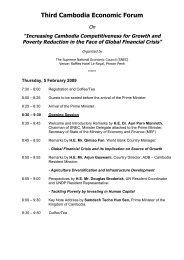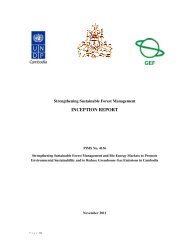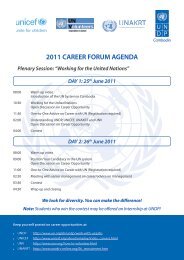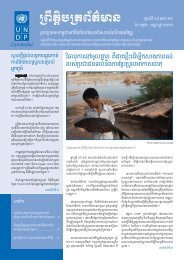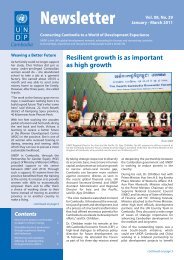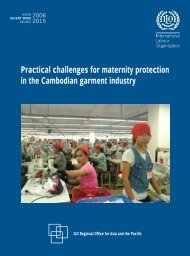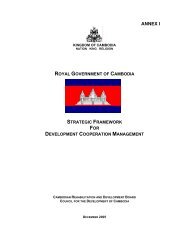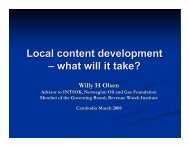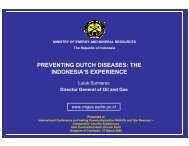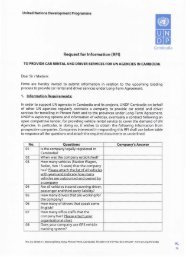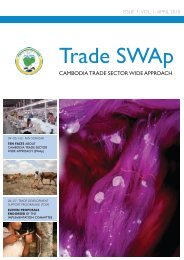UN Analysis Final.pdf - United Nations in Cambodia
UN Analysis Final.pdf - United Nations in Cambodia
UN Analysis Final.pdf - United Nations in Cambodia
You also want an ePaper? Increase the reach of your titles
YUMPU automatically turns print PDFs into web optimized ePapers that Google loves.
Youth political participation is still very low (COMFREL, 2008). The election monitor<strong>in</strong>g organization,<br />
COMFREL, notes that students with university-level education still do not pay much attention to vot<strong>in</strong>g,<br />
stat<strong>in</strong>g that they register only because their parents encourage them to or because they are follow<strong>in</strong>g the<br />
example of others. This seems to stem from a lack of encouragement, especially to girls, to engage <strong>in</strong> politics.<br />
Additionally, the Government does not allow political discussions and meet<strong>in</strong>gs <strong>in</strong> schools, because<br />
they are seen as neutral areas <strong>in</strong> which politics has no place (Yong 2005). This poses a constra<strong>in</strong>t on young<br />
people ga<strong>in</strong><strong>in</strong>g a critical political orientation or develop<strong>in</strong>g <strong>in</strong>formed op<strong>in</strong>ions.<br />
Where deeper participation <strong>in</strong> the electoral process is sought, engagement is said to occur through the<br />
youth w<strong>in</strong>gs of the three ma<strong>in</strong> political parties (the <strong>Cambodia</strong>n People’s Party, F<strong>UN</strong>CINPEC and the<br />
Sam Ra<strong>in</strong>sy Party) (Yong 2005). The first youth party, the Khmer Front Party, was formed <strong>in</strong> 2002. With<br />
students and young adults <strong>in</strong> its constituency, it has organized campaigns and demonstrations and<br />
sent petition letters on a number of key issues to high-rank<strong>in</strong>g officials, <strong>in</strong>clud<strong>in</strong>g the K<strong>in</strong>g (Yong 2005).<br />
Young people’s political expression has also been evident <strong>in</strong> media campaigns, the lobby<strong>in</strong>g of political<br />
leaders, and tak<strong>in</strong>g part <strong>in</strong> and help<strong>in</strong>g to organize demonstrations and public forums arranged by<br />
youth-focused NGOs (Yong 2005). Additionally, youth groups and associations have made conspicuous<br />
their commitment to <strong>in</strong>fluence the <strong>Cambodia</strong>n society by reach<strong>in</strong>g and work<strong>in</strong>g with <strong>in</strong>dividuals or groups<br />
with<strong>in</strong> their villages, communes, districts or prov<strong>in</strong>ces. Support for such political engagement by youth<br />
comes from a number of <strong>in</strong>ternational organizations and donors, <strong>in</strong>clud<strong>in</strong>g: the National Democratic<br />
Institute and the International Republican Institute, which conduct tra<strong>in</strong><strong>in</strong>g for youth affiliates of the political<br />
parties; and Forum Syd and EED, which help pave the way for the greater visibility of young people outside<br />
the political parties.<br />
8.4 POLICY AND PROGRAMMING IMPLICATIONS<br />
There are positive factors <strong>in</strong> <strong>Cambodia</strong> which support opportunities for youth to participate mean<strong>in</strong>gfully<br />
<strong>in</strong> social and political development processes. A key area that could provide a major opportunity for youth<br />
participation is the Government’s current decentralization and deconcentration effort, which would afford<br />
young people a chance to become <strong>in</strong>volved <strong>in</strong> the local development process. It also br<strong>in</strong>gs about<br />
opportunities for youth to participate as contractors for local government tenders for public works, such<br />
as the construction of roads, local bridges, schools and markets, and will allow them to become organized<br />
and be recognised by the local authorities.<br />
However, major hurdles that need to be overcome are those related to the idea that participation and<br />
leadership should come with age, knowledge and experience. The tendency to listen to youth and<br />
address their needs tends to be (1) limited to specific issues (such as violence and drug use) and only<br />
when they emerge as local concerns to elders. Or they tend to be (2) one-time <strong>in</strong>terventions that respond<br />
to an immediate visible problem. A rudimentary understand<strong>in</strong>g of the concepts of governance, democracy<br />
and the importance of youth participation <strong>in</strong> development is an added complication for youth and for<br />
leaders alike. Local (and national) leaders need to be at the forefront of embrac<strong>in</strong>g youth <strong>in</strong> all development<br />
endeavours. Capacity build<strong>in</strong>g and learn<strong>in</strong>g experiences should therefore <strong>in</strong>clude those who can <strong>in</strong>fluence<br />
and mentor young people to become active participants <strong>in</strong> their own development. Critical to this would be<br />
support to basic social <strong>in</strong>stitutions such as the family, the school, and community (pagodas, local leadership<br />
groups) that shape young people’s perspectives.<br />
94 Situation <strong>Analysis</strong> of Youth <strong>in</strong> <strong>Cambodia</strong>




